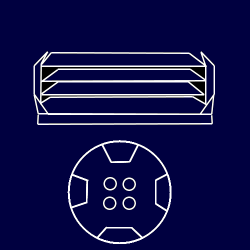Table of Contents
Shield Module Deployment System
The shield module deployment system is a system which is designed to be utilized to provide additional defense for starships, shuttles, and power armor. The system uses remotely controlled drones to produce and project a shield upon the drone's surface or between drones.
Produced By: United Manufacturing Cooperative Fielded by: United Manufacturing Cooperative Affiliates
Technical Information
Components
The shield module system drones utilize a Nerimium shell encased shield projection system with a gravitic propulsion system enclosed within. Each shield module utilizes a QNC to provide it's power. Optionally, these drones can be powered through remote power feed systems, and can be propelled by electromagnetic propulsion technology..
Each shield module uses gravitic and electromagnetic shield technology. The technology utilized within each drone is comparable to the components utilized in the Tenshi no Yoru 'Tenshi' Light Mechanized Power Armor project.
When not deployed, the system's drones are kept within a holding system. In starship applications the shield modules can be stored within launch bays. In personal and armored applications the system uses a mountable pack which holds the drones within a frame.
Each drone also includes an automated self-destruct system. The self-destruct is triggered by being separated without communication contact from its original launch platform for longer than a duration of a quarter of an hour. The self-destruct consists of a QNC reactor overload which effectively melts down the internal components of the drone.
Function
The shield module deployment system is controlled through the use of software integrated into the shield module deployment system which can be networked to the armor which the deployment system is integrated to, or to a communication system built into a cybernetic brain or the brain of a synthetic life form. Each shield module system can be locked-into interfacing with only a specific armor or individual signal.
When ordered to deploy, one or all of the drones contained in the deployment system disengage from the holding unit and propel themselves from the unit under their own power. The units can then be placed according to the desires of the user.
Deployed drones are capable of producing a shield over their surface which effectively makes the drone itself a barrier between incoming ordinance and the defended objective. Alternatively, the shield projections from several drones can be 'overlapped' to create a barrier between the drones. The barrier which can be produced varies depending on the application size.
Drones being held in the mounted carrying module can also be utilized to deflect or absorb damage much like a conventional arm-shield.
Scale
In armor, small shuttle, and personal applications, the system utilizes drones which are twelve inches in diameter, and three inches in thickness. The housing module itself is fifteen inches in diameter and fourteen inches in thickness and is capable of carrying four drones. In applications three to five meters in height, the module can be made to hold up to six drones.
Mecha-type and large shuttle armored applications are capable of utilizing a drone system which consists of four meter by one-half meter drones. The holding module itself is four and a half meters by five meters. The system is capable of holding up to eight drones.
Starship-type applications utilize the same drones used by mecha-type applications. Drones are to be held within the ship. The number of drones contained within the starship's launch bay is directly reliant upon the size of the ship which it is installed upon. Ships freighter through gunship can carry up to six drones. Cruiser through light carrier can carry up to twelve drones. Full size carrier to battleship can carry up to twenty-four drones. Shipyards and bases often carry up to forty-eight drones.
Usage
Deployed drones can be used to block incoming fire, however, the system's primary virtues shine in drone groups of three or more.
Limitations
'Line of sight' communication must be maintained with the origin platform. Failure to maintain this results in disruption of the controller data stream and de-activation of the remotely projected shield.
Line of sight in this case also includes energy fields as barriers to communication, thus; communications can not be maintained through a second obstructing shield. This also includes other field/bubble effect shield systems.
Drone Application Performance and Damage Ratings
The following indicates the damage ratings and areas able to be protected depending on the size of the application and number of drones available.
Personal, Small Shuttle, and Armor
| Max Space Between Drones | Two Meters |
| Application Size Class | Armor Light |
| Damage Rating | 0.8 x 5 (4) |
| Threshold | 4 |
Large Power Armor, Mecha, Large Shuttle
| Max Space Between Drones | Four Meters |
| Application Size Class | Armor Medium |
| Damage Rating | 0.8 x 15 (12) |
| Threshold | 4 |
Starship
| Max Space Between Drones | Six Meters |
| Application Size Class | Starship Light |
| Damage Rating | 0.8 x 20 (16) |
| Threshold | 5 |
